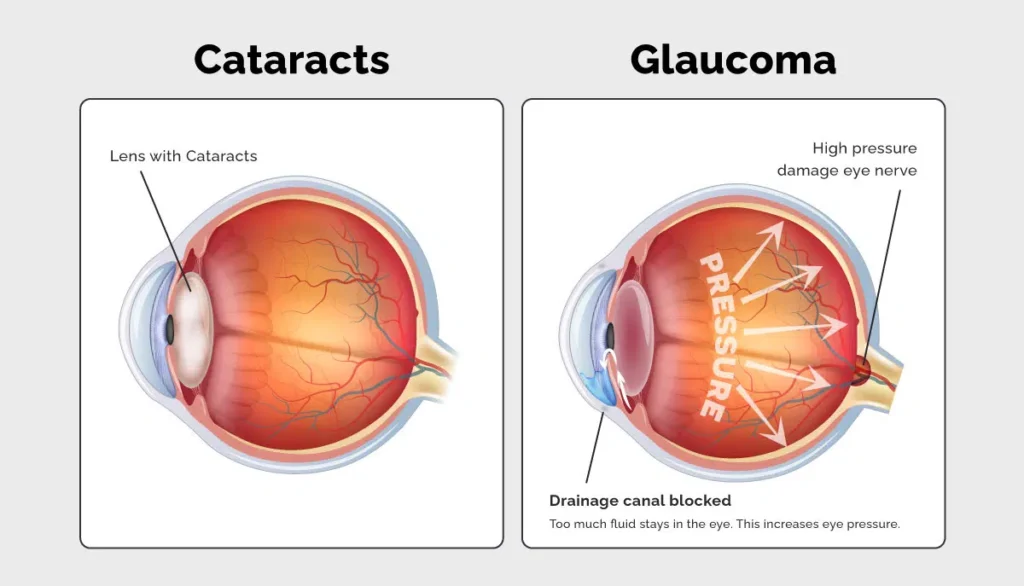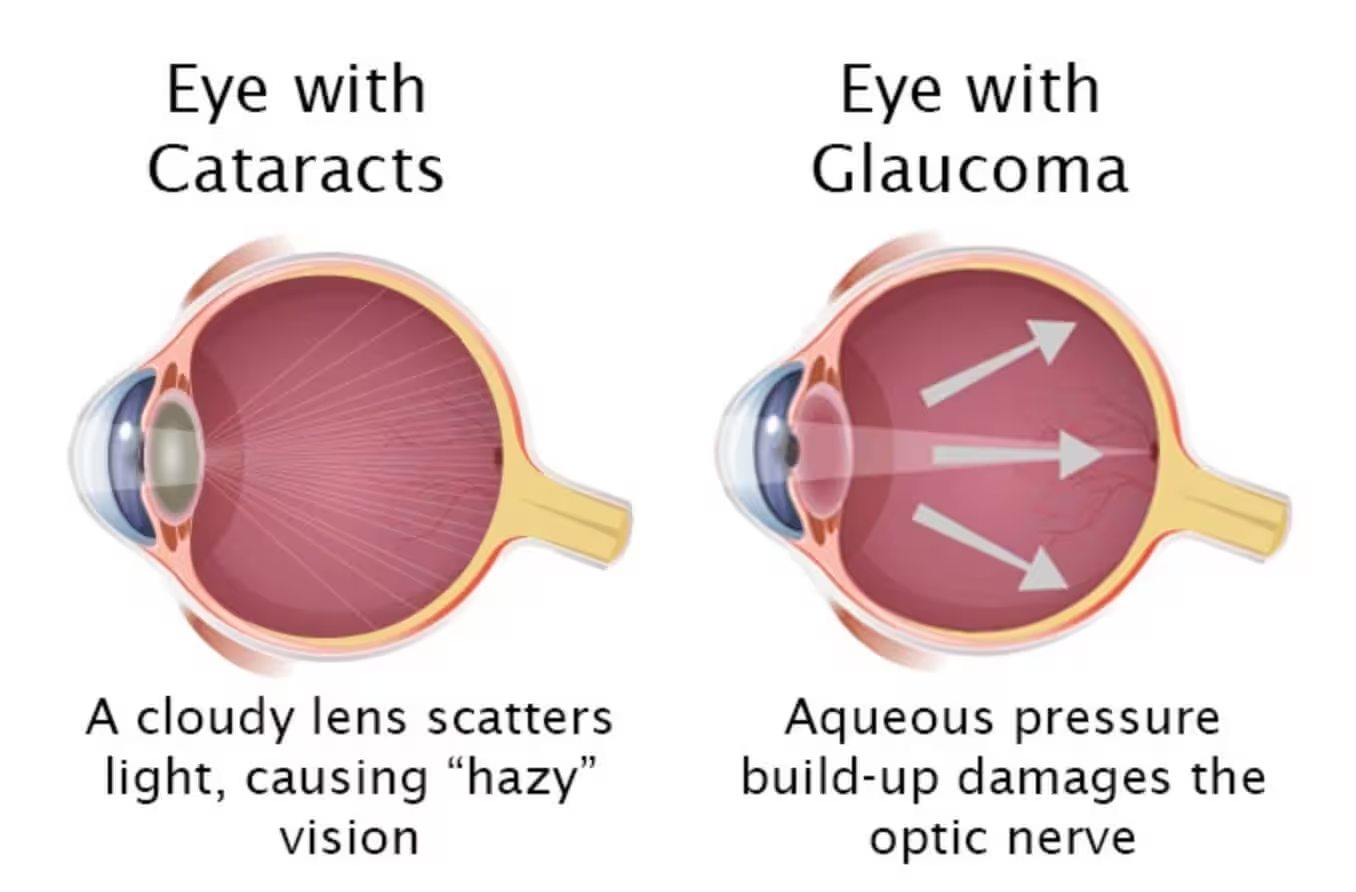
-
 Posted By shubham dhyani
Posted By shubham dhyani -
-
Comments 0
Let’s be honest – when your vision starts acting up, it’s scary. You might notice things getting blurry, or maybe you’re having trouble seeing at night. Two culprits that often get mixed up are cataracts and glaucoma. I get it; they both mess with your eyesight, but they’re actually quite different.
Here’s the thing: knowing the difference between cataract and glaucoma could literally save your sight. So let’s break this down in a way that actually makes sense.
What’s Really Going On With These Eye Health Conditions?
Think of your eye like a camera. Cataracts are like having a dirty lens – everything looks cloudy and dim. The lens in your eye, which should be crystal clear, gets gunked up with protein clumps over time. It’s super common as we age, though sometimes younger folks get them too.
Glaucoma? That’s a whole different story. This sneaky condition damages the optic nerve – basically, the cable that sends images from your eye to your brain. Usually happens because fluid builds up in your eye, creating pressure that slowly destroys this vital connection. The scary part? It often runs in families.
The big difference in cataract vs glaucoma?
LOCATION!!! Cataracts hit the front of your eye (the lens), while glaucoma attacks the back (the optic nerve).
Spotting the Signs: What Your Eyes Are Telling You

Cataract Symptoms – The Gradual Fog
Also read: https://theakio.com/cataract-treatment-in-delhi-ncr/
You know how your car windshield gets that film on it after a while? That’s kind of what cataracts feel like. Here’s what typically happens:
Your vision gets progressively cloudier, like looking through wax paper. Colours start looking washed out or yellowish. Ever notice how your grandma’s old photos have that yellow tint? That’s what everything might look like. Night driving becomes a nightmare because of glare and halos around streetlights.
The good news? It doesn’t hurt.
Most people describe it as looking through a fogged-up window that just won’t clear up, no matter how much you blink.
Glaucoma – The Silent Vision Thief
This one’s tricky because there are different types, and they behave very differently.
The common type (open-angle glaucoma) is brutally sneaky. You might not notice anything wrong until you’ve already lost significant vision. It nibbles away at your side vision first – you develop blind spots that gradually expand. People often don’t realize they’re losing peripheral vision until they bump into things or miss objects in their side view.
The emergency type (angle-closure glaucoma) is the opposite – it hits hard and fast. We’re talking severe eye pain, pounding headaches, nausea, and your eye might look red and feel rock-hard. This is a “drop everything and go to the Ophthalmologist” situation.
Also Read: How to Prepare for Cataract Surgery: A Step-by-Step Guide
The Difference Between Cataract and Glaucoma
Here’s what really sets these conditions apart:
The reversibility factor: This is huge. Cataract surgery can completely restore your vision – it’s like getting a brand new lens. Glaucoma damage? That’s permanent. Once those optic nerve fibres are gone, they’re gone forever. That’s why catching glaucoma early is absolutely critical.
How they progress: Cataracts are predictable – they slowly get worse over months or years. Glaucoma can silently steal 80-90% of your vision before you even notice something’s wrong. It’s why regular eye exams are so important, especially after 40.
The pain game: Cataracts rarely hurt. Some types of glaucoma can cause excruciating pain, while others cause no discomfort at all.

Treatment Approaches: What Actually Works
Fixing Cataracts
When cataracts start messing with your daily life – you can’t read, drive safely, or enjoy activities – it’s surgery time. Modern cataract surgery is pretty amazing. They use ultrasound to break up that cloudy lens and pop in a new artificial one. Most people are back to normal activities within days.
You’ve got choices with replacement lenses, too. Basic ones work great for distance vision. Fancier options can help with reading and computer work, too. Your surgeon will help you figure out what makes sense for your lifestyle.
Managing Glaucoma
Glaucoma treatment options are all about stopping further damage. Once you’re diagnosed, it’s usually a lifelong partnership with your eye doctor.
Eye drops are the first line of defence – they lower the pressure in your eye. Don’t love the idea of daily drops? There are laser treatments that can help your eyes drain better. For tougher cases, surgery might create new drainage channels.
The key thing to remember: treatment prevents further vision loss but can’t bring back what’s already gone.
Can You Deal With Both at Once?
Absolutely. It’s not uncommon to have both conditions, especially as you age. Sometimes a big cataract can actually cause glaucoma by blocking drainage. Other times, glaucoma surgery might speed up cataract formation. The good news is that eye surgeons deal with this combo regularly and have strategies to handle both.
When to Worry
Don’t mess around if you experience:
- Sudden vision changes
- Severe eye pain with nausea
- Gradual loss of side vision
- Increasing trouble with night driving
- Colors looking faded
Look, regular eye exams aren’t just for people with glasses. They’re your early warning system. For glaucoma, especially, catching it early can prevent 90% of vision loss.
Both cataracts and glaucoma are incredibly treatable when caught in time. The difference between cataract and glaucoma in terms of outcomes often comes down to timing. Don’t let fear or uncertainty keep you from getting the care you need.
Getting the Right Care When It Matters
Dealing with vision problems can feel overwhelming, and that’s completely normal. At AK Institute of Ophthalmology (AKIO), we see patients navigate these concerns every day. Our eye specialists use the latest technology, including advanced 3D cataract surgery, to provide comprehensive care that puts your vision and peace of mind first.
How AKIO Can Help You Manage Cataract and Glaucoma
AKIO isn’t just well-equipped — it’s thoughtful in how it treats eye conditions like cataracts and glaucoma. Our team uses updated tools and techniques, including bladeless cataract surgery and advanced glaucoma care, tailored to each case. Patients get full eye evaluations, not rushed exams, and treatment decisions are based on what actually works for them. Whether you need surgery, drops, or just careful monitoring, AKIO’s specialists know how to manage both conditions, without making it feel overwhelming.
Recent Posts
- Why You Need a Retina Specialist for Cataract Surgery – Cataract + Retina Issues Together
- Retina Injections (Anti-VEGF): Procedure, Cost, Effectiveness, Risk & Recovery Experience
- Early Signs of Retinal Detachment You Should Never Ignore
- Floaters vs Retina Detachment – How to Know the Difference?
- Manage Your Retina Conditions: Simple Healthy Habits for Better Vision



